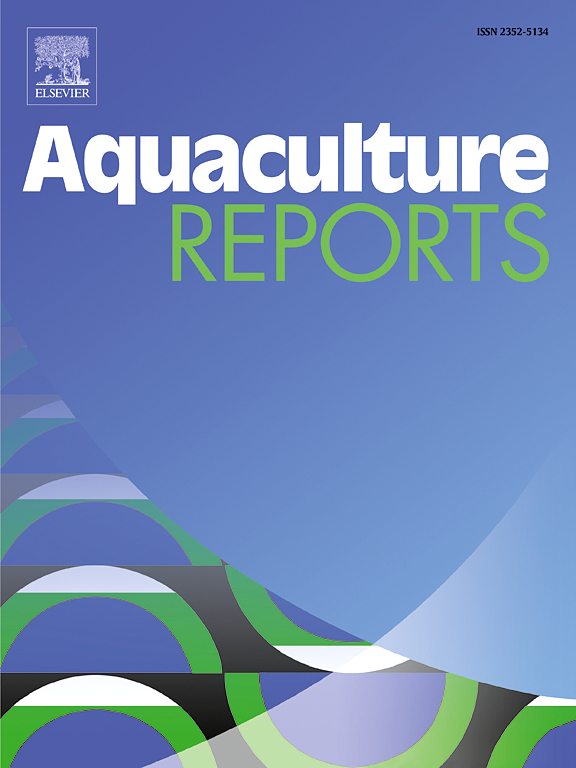Selection of antibacterial aptamers against Pseudomonas plecoglossicida and analysis on their potential binding proteins
IF 3.2
2区 农林科学
Q1 FISHERIES
引用次数: 0
Abstract
Pseudomonas plecoglossicida is one of the main pathogens causing visceral white spot disease of the large yellow croaker (Pseudosciaena crocea). Although antibiotics are used to control P. plecoglossicida infections, the long-term and large-scale use of antibiotics can lead to the development of drug-resistant bacteria as well as environmental pollution. Therefore, it is necessary to develop novel antibacterial agents to treat P. plecoglossicida infections. In this study, we first developed a two-step-centrifugation method to isolate live and dead P. plecoglossicida cells. Subsequently, we used the Systematic Evolution of Ligands by Exponential Enrichment (SELEX) screening based on inhibition rate to directly isolate antibacterial aptamers from the random library without post-processing. We isolated five antibacterial aptamers, namely B1, B2, B4, B8, and B109, which showed good inhibitory effects against P. plecoglossicida. Among these, B4 showed the highest inhibitory effect (62.40 ± 4.17 %). Further analysis revealed no positive correlation between the inhibitory effect of aptamers and their affinities with the target bacterium. The B4- and B109-binding proteins were isolated from P. plecoglossicida by magnetic separation and sodium dodecyl sulfate–polyacrylamide gel electrophoresis (SDS-PAGE). Mass spectrometry analysis revealed that the 26 kDa ribosomal protein L2 was the probable B4-binding protein, while the 26 kDa ribosomal protein S3 and 75 kDa ribosomal protein S1 or succinate dehydrogenase flavoprotein subunit were the probable B109-binding proteins. Structural and subcellular localization analyses of these potential B4- and B109-binding proteins were also conducted. Our findings suggest that the inhibitory activity of the antibacterial aptamers against P. plecoglossicida may be mediated via their interaction with the ribosomal proteins, which can interfere with the protein synthesis process in the bacterium, affecting its growth. These findings provide the scientific basis for the development of functional antibacterial aptamers and the elucidation of their mechanisms of action.
针对胸膜假单胞菌的抗菌肽的筛选及其潜在结合蛋白的分析
胸膜假单胞菌(Pseudomonas plecoglossicida)是导致大黄鱼(Pseudosciaena crocea)内脏白斑病的主要病原体之一。虽然抗生素可用于控制胸膜假单胞菌感染,但长期和大规模使用抗生素会导致耐药菌的产生以及环境污染。因此,有必要开发新型抗菌剂来治疗胸膜褶菌感染。在本研究中,我们首先开发了一种两步离心法来分离胸膜褶菌的活细胞和死细胞。随后,我们利用基于抑菌率的配体系统进化指数富集(SELEX)筛选法,直接从随机文库中分离出抗菌配体,而无需进行后处理。我们分离出了五种抗菌配体,即 B1、B2、B4、B8 和 B109,它们对胸膜褶菌有良好的抑制作用。其中,B4 的抑制效果最高(62.40 ± 4.17 %)。进一步的分析表明,适配体的抑制效果与其与目标细菌的亲和力之间没有正相关。通过磁性分离和十二烷基硫酸钠-聚丙烯酰胺凝胶电泳(SDS-PAGE),从胸膜褶菌中分离出了 B4 和 B109 结合蛋白。质谱分析表明,26 kDa 核糖体蛋白 L2 可能是 B4 结合蛋白,而 26 kDa 核糖体蛋白 S3 和 75 kDa 核糖体蛋白 S1 或琥珀酸脱氢酶黄蛋白亚基可能是 B109 结合蛋白。我们还对这些潜在的 B4 和 B109 结合蛋白进行了结构和亚细胞定位分析。我们的研究结果表明,抗菌肽对褶状舌杆菌的抑制活性可能是通过它们与核糖体蛋白的相互作用介导的,而核糖体蛋白会干扰该细菌的蛋白质合成过程,从而影响其生长。这些发现为开发功能性抗菌合剂和阐明其作用机制提供了科学依据。
本文章由计算机程序翻译,如有差异,请以英文原文为准。
求助全文
约1分钟内获得全文
求助全文
来源期刊

Aquaculture Reports
Agricultural and Biological Sciences-Animal Science and Zoology
CiteScore
5.90
自引率
8.10%
发文量
469
审稿时长
77 days
期刊介绍:
Aquaculture Reports will publish original research papers and reviews documenting outstanding science with a regional context and focus, answering the need for high quality information on novel species, systems and regions in emerging areas of aquaculture research and development, such as integrated multi-trophic aquaculture, urban aquaculture, ornamental, unfed aquaculture, offshore aquaculture and others. Papers having industry research as priority and encompassing product development research or current industry practice are encouraged.
 求助内容:
求助内容: 应助结果提醒方式:
应助结果提醒方式:


